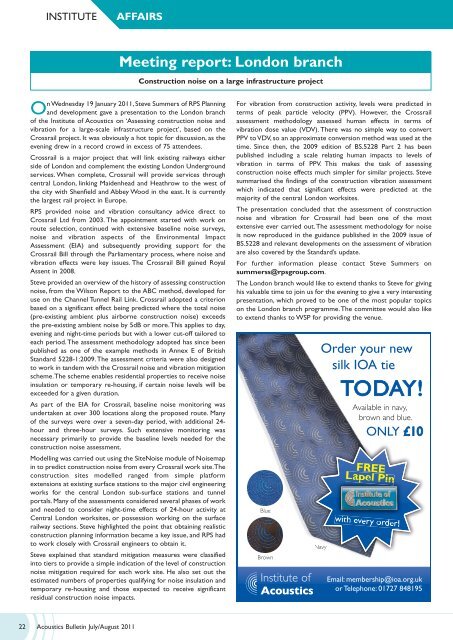Acoustics Bulletin Jul-Aug 2011 - Institute of Acoustics
Acoustics Bulletin Jul-Aug 2011 - Institute of Acoustics
Acoustics Bulletin Jul-Aug 2011 - Institute of Acoustics
You also want an ePaper? Increase the reach of your titles
YUMPU automatically turns print PDFs into web optimized ePapers that Google loves.
INSTITUTE<br />
AFFAIRS<br />
Meeting report: London branch<br />
Construction noise on a large infrastructure project<br />
On Wednesday 19 January <strong>2011</strong>, Steve Summers <strong>of</strong> RPS Planning<br />
and development gave a presentation to the London branch<br />
<strong>of</strong> the <strong>Institute</strong> <strong>of</strong> <strong>Acoustics</strong> on ‘Assessing construction noise and<br />
vibration for a large-scale infrastructure project’, based on the<br />
Crossrail project. It was obviously a hot topic for discussion, as the<br />
evening drew in a record crowd in excess <strong>of</strong> 75 attendees.<br />
Crossrail is a major project that will link existing railways either<br />
side <strong>of</strong> London and complement the existing London Underground<br />
services. When complete, Crossrail will provide services through<br />
central London, linking Maidenhead and Heathrow to the west <strong>of</strong><br />
the city with Shenfield and Abbey Wood in the east. It is currently<br />
the largest rail project in Europe.<br />
RPS provided noise and vibration consultancy advice direct to<br />
Crossrail Ltd from 2003. The appointment started with work on<br />
route selection, continued with extensive baseline noise surveys,<br />
noise and vibration aspects <strong>of</strong> the Environmental Impact<br />
Assessment (EIA) and subsequently providing support for the<br />
Crossrail Bill through the Parliamentary process, where noise and<br />
vibration effects were key issues. The Crossrail Bill gained Royal<br />
Assent in 2008.<br />
Steve provided an overview <strong>of</strong> the history <strong>of</strong> assessing construction<br />
noise, from the Wilson Report to the ABC method, developed for<br />
use on the Channel Tunnel Rail Link. Crossrail adopted a criterion<br />
based on a significant effect being predicted where the total noise<br />
(pre-existing ambient plus airborne construction noise) exceeds<br />
the pre-existing ambient noise by 5dB or more. This applies to day,<br />
evening and night-time periods but with a lower cut-<strong>of</strong>f tailored to<br />
each period. The assessment methodology adopted has since been<br />
published as one <strong>of</strong> the example methods in Annex E <strong>of</strong> British<br />
Standard 5228-1:2009. The assessment criteria were also designed<br />
to work in tandem with the Crossrail noise and vibration mitigation<br />
scheme. The scheme enables residential properties to receive noise<br />
insulation or temporary re-housing, if certain noise levels will be<br />
exceeded for a given duration.<br />
As part <strong>of</strong> the EIA for Crossrail, baseline noise monitoring was<br />
undertaken at over 300 locations along the proposed route. Many<br />
<strong>of</strong> the surveys were over a seven-day period, with additional 24-<br />
hour and three-hour surveys. Such extensive monitoring was<br />
necessary primarily to provide the baseline levels needed for the<br />
construction noise assessment.<br />
Modelling was carried out using the SiteNoise module <strong>of</strong> Noisemap<br />
in to predict construction noise from every Crossrail work site. The<br />
construction sites modelled ranged from simple platform<br />
extensions at existing surface stations to the major civil engineering<br />
works for the central London sub-surface stations and tunnel<br />
portals. Many <strong>of</strong> the assessments considered several phases <strong>of</strong> work<br />
and needed to consider night-time effects <strong>of</strong> 24-hour activity at<br />
Central London worksites, or possession working on the surface<br />
railway sections. Steve highlighted the point that obtaining realistic<br />
construction planning information became a key issue, and RPS had<br />
to work closely with Crossrail engineers to obtain it.<br />
Steve explained that standard mitigation measures were classified<br />
into tiers to provide a simple indication <strong>of</strong> the level <strong>of</strong> construction<br />
noise mitigation required for each work site. He also set out the<br />
estimated numbers <strong>of</strong> properties qualifying for noise insulation and<br />
temporary re-housing and those expected to receive significant<br />
residual construction noise impacts.<br />
For vibration from construction activity, levels were predicted in<br />
terms <strong>of</strong> peak particle velocity (PPV). However, the Crossrail<br />
assessment methodology assessed human effects in terms <strong>of</strong><br />
vibration dose value (VDV). There was no simple way to convert<br />
PPV to VDV, so an approximate conversion method was used at the<br />
time. Since then, the 2009 edition <strong>of</strong> BS.5228 Part 2 has been<br />
published including a scale relating human impacts to levels <strong>of</strong><br />
vibration in terms <strong>of</strong> PPV. This makes the task <strong>of</strong> assessing<br />
construction noise effects much simpler for similar projects. Steve<br />
summarised the findings <strong>of</strong> the construction vibration assessment<br />
which indicated that significant effects were predicted at the<br />
majority <strong>of</strong> the central London worksites.<br />
The presentation concluded that the assessment <strong>of</strong> construction<br />
noise and vibration for Crossrail had been one <strong>of</strong> the most<br />
extensive ever carried out. The assessment methodology for noise<br />
is now reproduced in the guidance published in the 2009 issue <strong>of</strong><br />
BS.5228 and relevant developments on the assessment <strong>of</strong> vibration<br />
are also covered by the Standard’s update.<br />
For further information please contact Steve Summers on<br />
summerss@rpsgroup.com.<br />
The London branch would like to extend thanks to Steve for giving<br />
his valuable time to join us for the evening to give a very interesting<br />
presentation, which proved to be one <strong>of</strong> the most popular topics<br />
on the London branch programme. The committee would also like<br />
to extend thanks to WSP for providing the venue.<br />
Blue<br />
Brown<br />
Navy<br />
Order your new<br />
silk IOA tie<br />
TODAY!<br />
Available in navy,<br />
brown and blue.<br />
ONLY £10<br />
FREE<br />
Lapel Pin<br />
with every order!<br />
Email: membership@ioa.org.uk<br />
or Telephone: 01727 848195<br />
22 <strong>Acoustics</strong> <strong>Bulletin</strong> <strong>Jul</strong>y/<strong>Aug</strong>ust <strong>2011</strong>

















